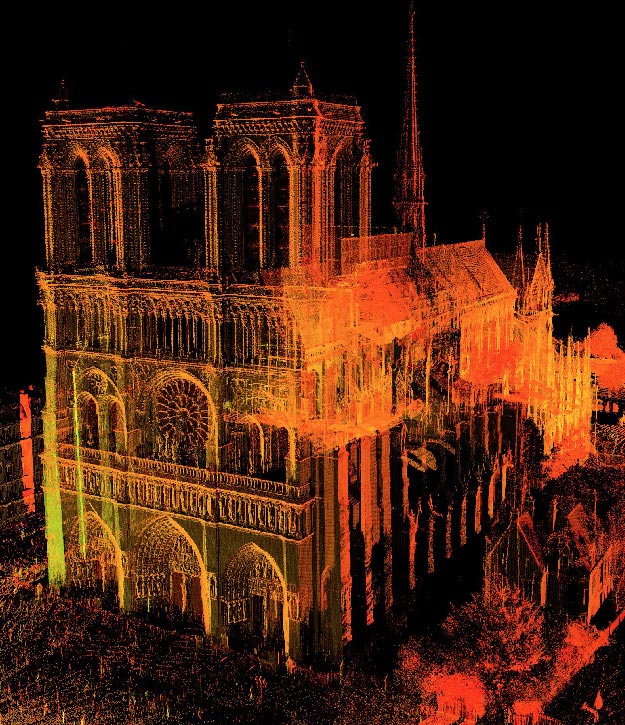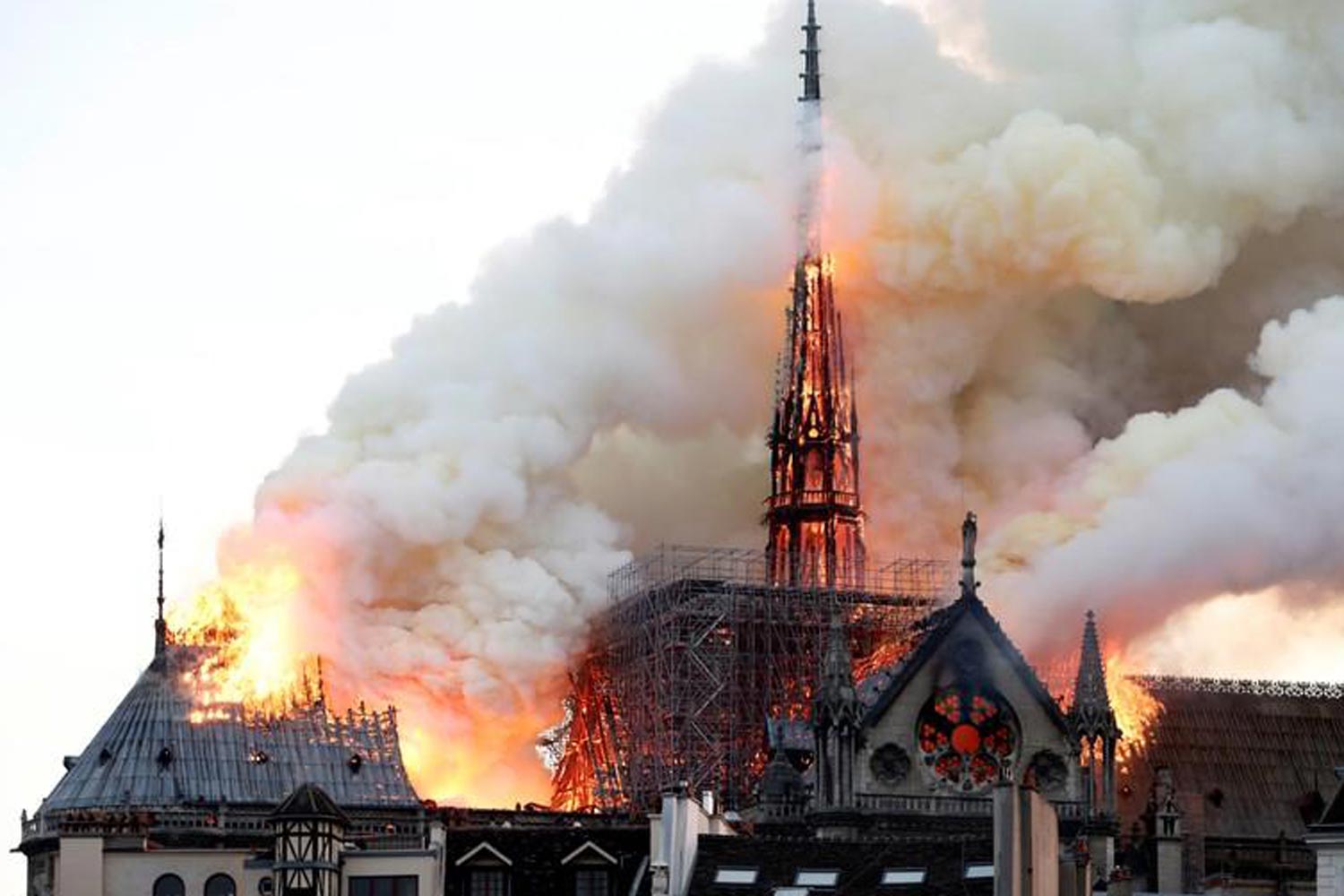Virtual copies of the Notre Dame Cathedral’s interior and exterior could guide repair efforts and help preserve the building’s unique heritage.
Last week, one of the world’s most famous buildings, Paris’ Notre Dame Cathedral, was consumed by flames. The fire started in the building’s roof and is suspected to have been linked to repair works currently underway.
It seemed like the historic site would be lost forever, but technology, and digital imaging in particular, is lending new hope to recovery efforts.
The late Vassar College art historian Andrew Tallon took meticulous scans of the 856-year-old cathedral to preserve its every detail in bytes of data. The project was completed in 2015 as a way to chronicle the architectural history of the building — especially important as its original builders left no records of its provenance or construction.
“So much ink has been spilled over that building … so much of it is completely wrong,” Tallon said in a 2015 interview with National Geographic.
“So I’ve been using more sophisticated technology these days to try to get new answers from the buildings.”
One billion points
Tallon, along with Columbia University’s Paul Blaer, used laser scanners to get inside the heads of medieval builders and deconstruct the cathedral.
“Every building moves. It heaves itself out of shape when foundations move, when the sun heats up on one side,” he said.
Tracking these movements required precision beyond the scope of low-tech measuring tools like plumb-bobs, string and rulers. Laser scanners, on the other hand, don’t miss a thing.

A tripod-mounted laser made sweeps of more than 50 locations inside and outside of Notre Dame. Together these scans created more than 1 billion data points.
“If you’ve done your job properly, [the scan] is accurate to within 5 millimetres,” Tallon said.
To further increase the accuracy of his scans, Tallon would also take a spherical panoramic photograph from the same spot. The photograph was then mapped onto the 3D scan, which merged the data points into pixels corresponding to the colour of that location in the photograph.
The results are stunningly lifelike renderings of Notre Dame’s interior and exterior from a variety of angles. They also yielded some surprising insights about Notre Dame’s builders, who apparently took a lot of “shortcuts”, according to Tallon. For example, some of the interior columns in the cathedral’s nave don’t line up because they were built around existing structures.
The scans also confirmed suspicions that the western façade was built on unstable soil, which caused construction delays and resulted in the Gallery of Kings — the line of statues above the three massive doorways — to be 30 centimetres out of vertical alignment.
Tallon used this same technology to create detailed digital copies of 45 other historical buildings. The technology has also been used to create small-scale models of old buildings with 3D printers. Digital replicas and models like these allow engineers and researchers to gauge the stability and safety of ancient masonry structures.
Repair or rebuild?
In a strange twist of fate, Notre Dame has been in desperate need of repairs for years — and this fire has galvanised people into action. At the time of the fire, the budget for the renovation that the church was undergoing was only $9.5 million; in the week since the fire, almost $1 billion has been pledged for repairs.
Firefighters held the line, combating the blaze and deploying equipment to prevent key support structures from collapsing, as well as rescuing as many artefacts as possible. However, the overall structure remains fragile.
“If the vaults start to crack and fall down, then the building is going to be lost,” said Robert Bork, an architectural historian at the University of Iowa, in an interview with Wired. He called the loss of Notre Dame’s roof, containing 5000 oak beams that date back to the 12th and 13th centuries, “incomparable”.
“This was quite special, and it was from the time that they were really developing roof techniques,” he said.
Parts of the support structure around the stained glass rose windows will be dismantled to limit further damage and risk to them after the walls were found to be leaning 20 centimetres towards the street post-fire.
A competition has also been announced to redesign the cathedral’s iconic lead and wood spire, which collapsed in the blaze.
“The international competition will allow us to ask the question of whether we should recreate the spire as it was conceived by Viollet-le-Duc; or whether, as is often the case during the evolution of heritage, we should endow Notre Dame with a new spire that reflects the techniques and challenges of our era,” said the Culture Ministry’s fire expert Jose Vaz de Matos.

Questions are also emerging about whether such an event could have been prevented in the first place. Notre Dame apparently lacked firestops and adequate sprinkler systems, largely due to fears of altering the cathedrals design or structure.
All together, the roof, the spire, parts of the choir and nave, and part of the support structure around the rose windows will need to be rebuilt. But the structure of the cathedral itself was saved, and two bell towers still stand.
“Perfection is not the aim”
French President Emmanuel Macron insisted Notre Dame would be restored in as little as five years. Tallon’s scans could provide a map for this work, though perhaps not everything can be restored to its original glory.
Restorations and repairs of similar structures provide clues as to how modern technology might be integrated into the old structure, but it’s unlikely Notre Dame will ever be as it once was. Reproducing the roof alone would require a forest of 1300 trees, for example.
“Original hand craftsmanship is irreplaceable. When you restore it, it’s not exactly the same thing,” Bork said.
The Notre Dame we know is the result of centuries of work. As Tallum’s digital replicas show, Notre Dame’s quirks and features reflect the building’s rich history.
According to Bernard Fonquernie, the architect who led a Notre Dame upgrade in 1992, restorations are a chance to correct the sins of the past, such as those made in the 1800s that used cement and even lead to seal joints instead of the more porous materials that medieval builders would have used. He also said that Notre Dame’s imperfections demand respect and attention.
“It looks so balanced, so symmetric,” he said in a 1992 piece for the New York Times. Yet in reality, “much of the building is crooked.” It’s this unevenness that gives old structures their character, he added. Perfection is not the aim.
“This cathedral was made by many pairs of hands and each pair was different. We cannot put in stones or lines that are too perfectly cut.”
In the coming years, it will be interesting to watch these next steps in Notre Dame’s evolution.



